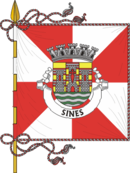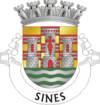Sines Municipality
| Sines | |||
|---|---|---|---|
| Municipality | |||

A monument to Vasco da Gama who was christened in the parish church of Sines, and whose father was the alcade-mor of the castle
|
|||
|
|||
 |
|||
| Coordinates: 37°57′17″N 8°51′52″W / 37.95472°N 8.86444°WCoordinates: 37°57′17″N 8°51′52″W / 37.95472°N 8.86444°W | |||
| Country |
|
||
| Region | Alentejo | ||
| Subregion | Alentejo Litoral | ||
| Intermunic. comm. | Alentejo Litoral | ||
| District | Setúbal | ||
| Parishes | 2 | ||
| Government | |||
| • President | Nuno José Gonçalves Mascarenhas (PS) | ||
| Area | |||
| • Total | 203.30 km2 (78.49 sq mi) | ||
| Elevation | 49 m (161 ft) | ||
| Population (2015 INE) | |||
| • Total | 18,298 | ||
| • Density | 90/km2 (230/sq mi) | ||
| Time zone | WET/WEST (UTC+0/+1) | ||
| Postal code | 7520 | ||
| Area code | 286 | ||
| Website | http://www.cm-sines.pt/ | ||
Sines (Portuguese pronunciation: [ˈsin(ɨ)ʃ]) is a Portuguese city of Setubal district, the Alentejo region and subregion of the Alentejo coast, with about 18,298 inhabitants (2015 INE). Find the largest and the first port area of Portugal and the main city industrial port logistics in Portugal and the birthplace of Vasco da Gama.
It is the seat of a municipality with 203.30 km ² of area and 18,598 inhabitants (2015 INE), divided into two parishes. The municipality is bordered to the north and east by the municipality of Santiago do Cacém, south and west by Odemira has coastline on the Atlantic Ocean. The coastline of the city, south of San Torpes, is part of the Natural Park of Southwest Alentejo and Costa Vicentina.
Vestiges of a few settlements have today been discovered in archaeological sites, such as Palmeirinha and Quitéria, that attest to the age of human settlements in Sines. Arnaldo Soledade (1981) noted that these Visigoths, identified as Cinetos, may have been the original civilization that gave rise to the community, suggesting the local toponymy may have derived from this; Cinetos, to Cines and, finally, Sines. Although this tribes lineage is not clearly defined, Soledade goes on to refer to the construction of a castro where the current Castle stands. The Punics, are thought to have also had a presence in the area; a Punic artifact, the Tesouro do Gaio was unearthed in 1966, and is on guard in the Museu of Sines (English: Sines Museum). Discovered in May 1966, the treasure was unearthed by a local farmer, Francisco da Silva Campos, who was tilling his land to plant corn, and discovered a schist tomb with women's jewellery in his plot of land in Herdade do Gaio (12.5 km south-east of Sines, 7 km from the coast and 275m from Ribeira de Morgavel). Between 1966 and 1967, investigator José Miguel da Costa, discovered several of these Punic graves, but all showing evidence of early tomb raiding. While the jewellery was determined to be Punic in origin, the symbolism on the artefacts were characterized as Egyptian. On the island of Pessegueiro, there is also evidence of Ibero-Punic artefacts discovered under the Roman port, discovered by archeologists Carlos Tavares da Silva and Joaquina Soares (1981). Roman occupation brought the destruction of many of these artefacts associated with the Iron Age.
...
Wikipedia


